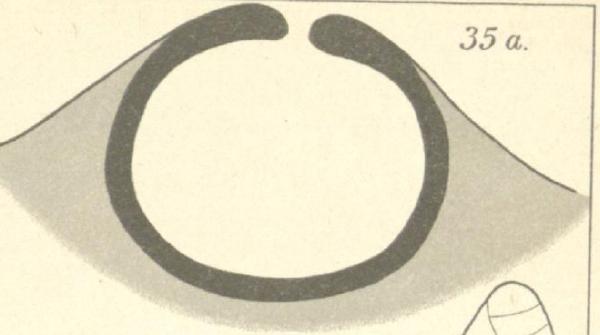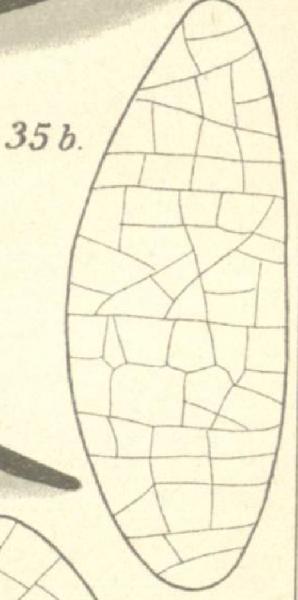Sporodictyon terrestre (Th. Fr.) Savić & Tibell
in Savic, Acta Universitatis Upsaliensis, 370: 18, 2007. Basionym: Polyblastia terrestris Th. Fr. - N. Acta Reg. Soc. Sci. Upsal., ser. 3, 3: 365, 1861.
Synonyms: Polyblastia fartilis (Nyl.) Boistel; Polyblastia inumbrata (Nyl.) Arnold; Polyblastia sommerfeltii Lynge; Polyblastia subviridicans (Nyl.) A.L. Sm.; Polyblastia tarvesedis (Anzi) Bagl. & Carestia; Polyblastia turicensis (G. Winter) Zschacke; Sporodictyon turicense G. Winter; Thelotrema tarvesedis Anzi; Verrucaria fartilis Nyl.; Verrucaria inumbrata Nyl.; Verrucaria subviridicans Nyl.
Distribution: N - TAA (Bilovitz & al. 2014b), Lomb (Hafellner 2010), Piem (Isocrono & al. 2004), VA (Valcuvia 2000), Emil (Tretiach & al. 2008, Fariselli & al. 2020).
Description: Thallus crustose, episubstratic, greenish grey to ash-grey, slightly uneven to usually verrucose, of indistinct, areole-like units. Cephalodia frequent, almost black, forming verrucose aggregations. Pseudocortex 6-10 µm thick, with minute crystals. Perithecia black, forming 0.4-0.8 mm wide projections, usually at least partially covered by an uneven to verrucose, pseudocorticate thalline layer. Involucrellum well developed, 80-125 μm thick, fused with exciple in upper part, reaching the base of the perithecium; exciple 20-25 μm thick, dark throughout; hamathecium of periphyses and periphysoids, interascal filaments absent; hymenial gel hemiamyloid, I+ red (I+ blue at very low concentrations of I), K/I+ blue. Asci 8-spored, clavate, K/I-, fissitunicate, the wall thickened above, with an ocular chamber, dehiscent by extrusion of an endotunica to form a delicate rostrum. Ascospores muriform, colourless or faintly brownish when overmature, ellipsoid or often slightly curved with one end slightly wider 51-65 x 22-30 μm. Photobiont chlorococcoid, Nostoc in the cephalodia. Spot tests: K-, C-, KC-, P-, UV-. Chemistry: without lichen substances. Note: an arctic-alpine, polymorphic species found on calciferous to neutral or slightly acidic siliceous rocks by streams, often in the splash zone, more rarely on base-rich soil (but spreading from small pebbles), sometimes also on bare ground and amongst bryophytes, usually near or above treeline. For further details see Savić & Tibell (2009) and Roux & coll. (2014: 905, 1105).
Growth form: Crustose
Substrata: rocks, soil, terricolous mosses, and plant debris
Photobiont: green algae other than Trentepohlia
Reproductive strategy: mainly sexual
Poorly known taxon in need of further study
Commonnes-rarity: (info)
Alpine belt: very rare
Subalpine belt: very rare
Oromediterranean belt: absent
Montane belt: absent
Submediterranean belt: absent
Padanian area: absent
Humid submediterranean belt: absent
Humid mediterranean belt: absent
Dry mediterranean belt: absent
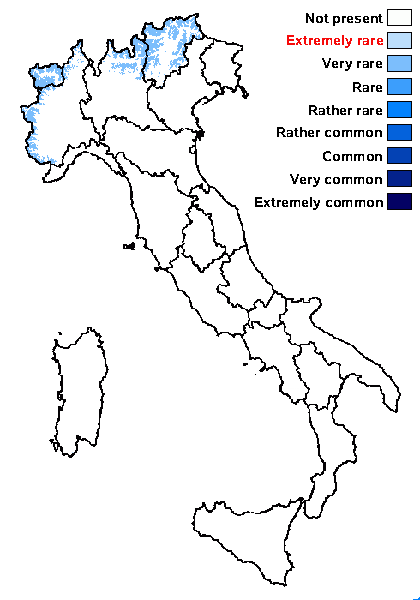
Predictive model
Herbarium samples


P.L. Nimis; Owner: Department of Life Sciences, University of Trieste
Herbarium: GZU Herb.Hafellner (3751)
2003/04/28


P.L. Nimis; Owner: Department of Life Sciences, University of Trieste
Herbarium: GZU Herb.Hafellner (3751)
2003/04/28
sectioned apothecium
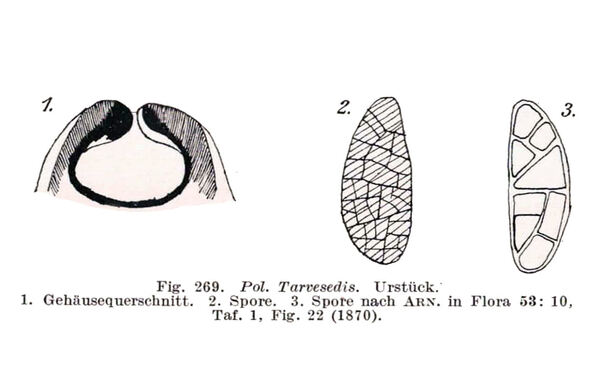
Source: Zschacke, H. (1934) Epigloeaceae, Verrucariaceae und Dermatocarpaceae. In: Dr. L. Rabenhorst‘s Kryptogamen-Flora, Band 9, Abt. 1, Teil 1. Akademische Verlagsgesellschaft, Leipzig, 695 pp. - Public Domain
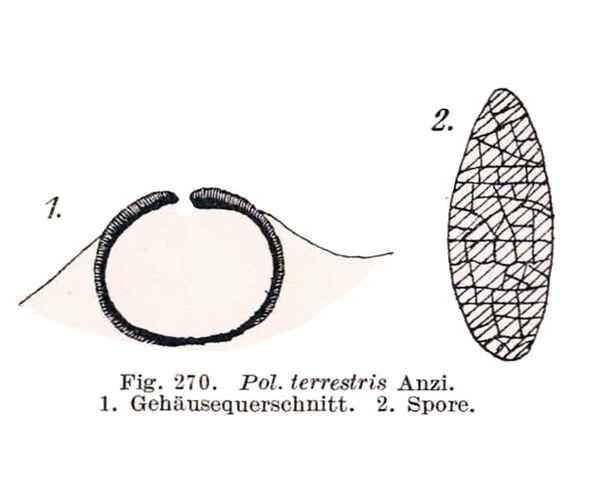
Source: Zschacke, H. (1934) Epigloeaceae, Verrucariaceae und Dermatocarpaceae. In: Dr. L. Rabenhorst‘s Kryptogamen-Flora, Band 9, Abt. 1, Teil 1. Akademische Verlagsgesellschaft, Leipzig, 695 pp. - Public Domain

Source: Zschacke H. 1914. Die mitteleuropäsche Verrucariaceen. II. Hedwigia, 55: 286-324. Public Domain
33. P. turicensis Orig.: 2 Perithezien.
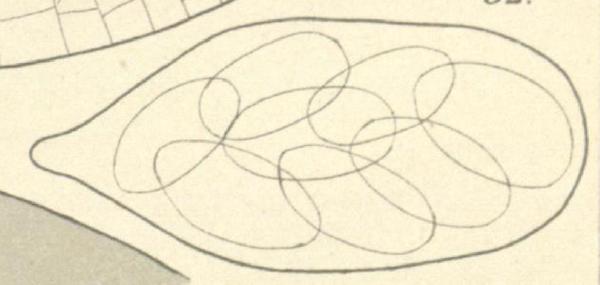
Source: Zschacke H. 1914. Die mitteleuropäsche Verrucariaceen. II. Hedwigia, 55: 286-324. Public Domain
32. P. jartilis Orig.: Schlauch.
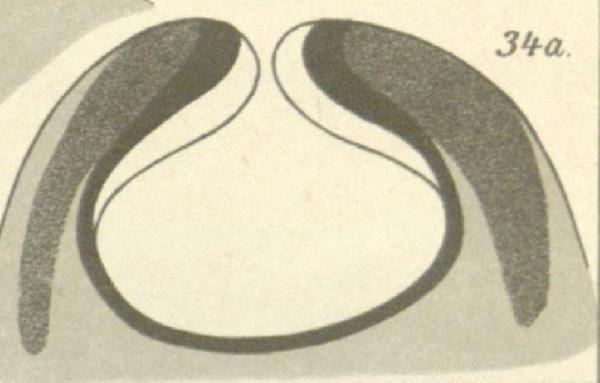
Source: Zschacke H. 1914. Die mitteleuropäsche Verrucariaceen. II. Hedwigia, 55: 286-324. Public Domain
34. P. Tarvesedis Orig.: a Perithezium, b, c, d Sporen.
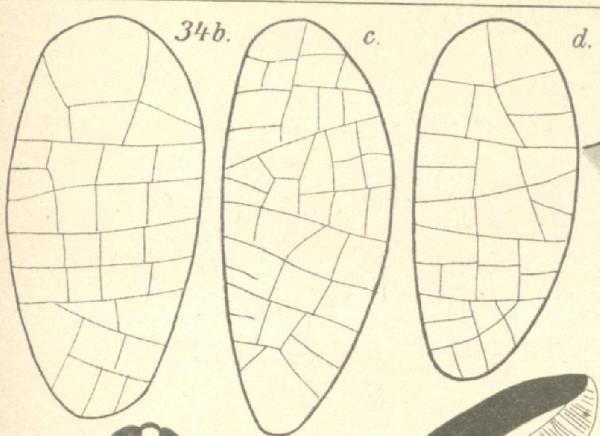
Source: Zschacke H. 1914. Die mitteleuropäsche Verrucariaceen. II. Hedwigia, 55: 286-324. Public Domain
34. P. Tarvesedis Orig.: a Perithezium, b, c, d Sporen.
Growth form: Crustose
Substrata: rocks, soil, terricolous mosses, and plant debris
Photobiont: green algae other than Trentepohlia
Reproductive strategy: mainly sexual
Poorly known taxon in need of further study
Commonnes-rarity: (info)
Alpine belt: very rare
Subalpine belt: very rare
Oromediterranean belt: absent
Montane belt: absent
Submediterranean belt: absent
Padanian area: absent
Humid submediterranean belt: absent
Humid mediterranean belt: absent
Dry mediterranean belt: absent

Predictive model
| Herbarium samples |


P.L. Nimis; Owner: Department of Life Sciences, University of Trieste
Herbarium: GZU Herb.Hafellner (3751)
2003/04/28


P.L. Nimis; Owner: Department of Life Sciences, University of Trieste
Herbarium: GZU Herb.Hafellner (3751)
2003/04/28
sectioned apothecium

Source: Zschacke, H. (1934) Epigloeaceae, Verrucariaceae und Dermatocarpaceae. In: Dr. L. Rabenhorst‘s Kryptogamen-Flora, Band 9, Abt. 1, Teil 1. Akademische Verlagsgesellschaft, Leipzig, 695 pp. - Public Domain

Source: Zschacke, H. (1934) Epigloeaceae, Verrucariaceae und Dermatocarpaceae. In: Dr. L. Rabenhorst‘s Kryptogamen-Flora, Band 9, Abt. 1, Teil 1. Akademische Verlagsgesellschaft, Leipzig, 695 pp. - Public Domain

Source: Zschacke H. 1914. Die mitteleuropäsche Verrucariaceen. II. Hedwigia, 55: 286-324. Public Domain
33. P. turicensis Orig.: 2 Perithezien.

Source: Zschacke H. 1914. Die mitteleuropäsche Verrucariaceen. II. Hedwigia, 55: 286-324. Public Domain
32. P. jartilis Orig.: Schlauch.

Source: Zschacke H. 1914. Die mitteleuropäsche Verrucariaceen. II. Hedwigia, 55: 286-324. Public Domain
34. P. Tarvesedis Orig.: a Perithezium, b, c, d Sporen.

 INDEX FUNGORUM
INDEX FUNGORUM
 GBIF
GBIF
 DOLICHENS
DOLICHENS

